In this article, we will learn the vapor absorption refrigeration cycle along with the definition, working, parts, advantages, disadvantages, applications, etc. Let’s explore!
What is Vapor Absorption Refrigeration Cycle?
Vapor Absorption Refrigeration Cycle Basics
The vapor absorption refrigeration cycle works on one of the oldest methods of producing the refrigerating effect. French scientist Ferdinand Carré developed a vapor absorption refrigerator in 1860. Ammonia is usually used as a refrigerant in this cycle.
- It uses heat energy instead of mechanical energy (in the vapor compression cycle), in order to change refrigerant conditions to the desired value.
- A cooling effect is produced by the refrigerant in the evaporator and heat is released to the atmosphere through the condenser.
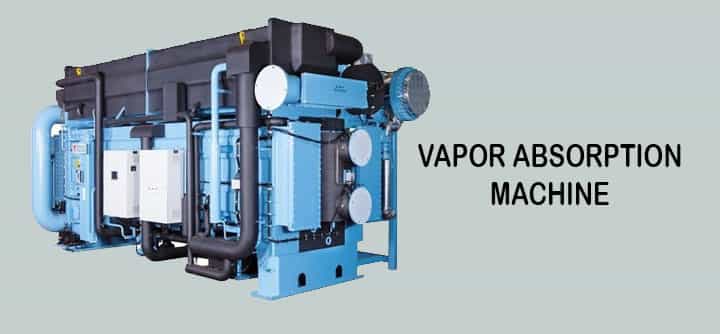
Vapor Absorption Refrigeration Cycle Definition
A type of thermodynamic cycle in which refrigeration is produced by absorption of the refrigerant is called the Vapor absorption refrigeration cycle. Unlike the vapor compression cycle, no compressor is used in the vapor absorption cycle. The compressor is replaced by a three-step process accomplished by the absorber, pump, and generator.
Parts of Vapor Absorption Refrigeration Cycle
The vapor absorption cycle has more parts than the vapor compression cycle. The main parts of the vapor absorption cycle are as follows.
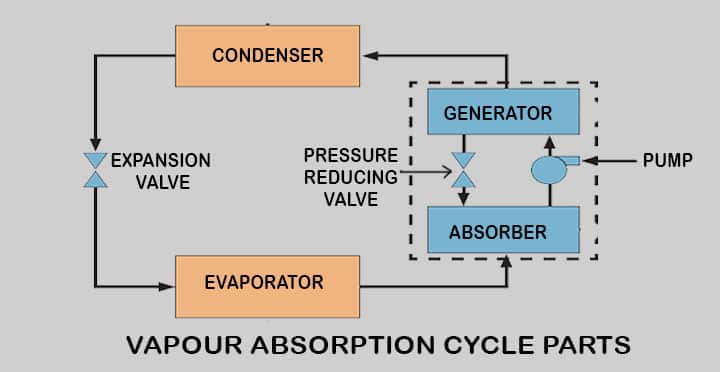
Evaporator
The evaporator is used to provide cooling to the surrounding area with which it is in contact. The low-pressure, low-temperature refrigerant enters the evaporator to produce a cooling effect. The chilled liquid when entered the evaporator will receive heat from the surrounding area and convert to vapor.
Absorber
It has the function to convert weak solutions into strong solutions by absorbing refrigerant. Absorber contains the weak solution of water and ammonia. It is a type of vessel containing water and ammonia. When ammonia-water pair is used, water acts as the absorbent, and ammonia acts as a refrigerant.
Pump
It is used to pump the strong solution of water and ammonia from the absorber to the generator. The pressure of a strong solution is raised to condenser pressure.
Condenser
Inside the condenser, the refrigerant gets condensed and converted to the liquid phase.
Expansion valve
The main function of the expansion valve is to suddenly reduce the pressure and temperature of the refrigerant and convert it into chilled liquid. Then the refrigerant enters the evaporator.
is to suddenly reduce the pressure and temperature of the refrigerant and convert it into chilled liquid. Then the refrigerant enters the evaporator.
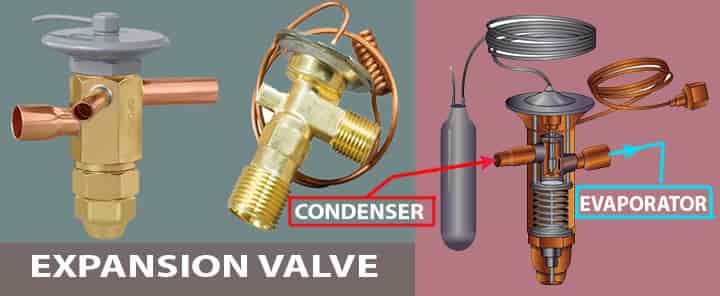
Generator
As the solution of ammonia and water is used inside the vapor absorption system, heat is provided to the generator from outside to convert this solution to vapors. The separation of vapors occurs in the generator. Let’s see some additional Parts! A practical vapor absorption cycle has three additional parts named:
- Analyzer
- Rectifier
- Heat exchanger
Analyzer
During the vaporization of ammonia inside the generator, the water gets vaporized and flows towards the condenser. This will reduce the efficiency of the refrigeration system. To cope with this problem, we make use of an analyzer.
- The analyzer is a type of distillation column with a large number of horizontal plates.
- It is located on top of the generator.
- Once ammonia vapor along with water enters the analyzer, the solution gets cooled.
- Water gets condensed and drops down into the generator.
- The ammonia vapor moves up and leaves the analyzer in the gaseous state.
Rectifier
Once the ammonia vapor leaves the analyzer it enters the rectifier. Any amount of water still left in ammonia vapors is removed in the rectifier. It acts as a vapor cooler which further dehydrates ammonia vapor.
Heat exchanger
A heat exchanger is present between the generator and pump to cool the weak solution returning from the generator to the absorber. Similarly, the strong solution moving towards the generator gets heated.
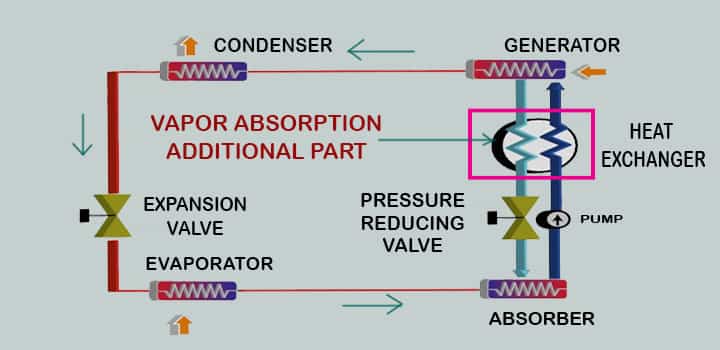
- In this way, less energy will be required to increase the temperature of the strong solution inside the generator.
- This will increase the efficiency of our vapor absorption cycle.
Working of Vapor Absorption Refrigeration Cycle
In the Vapour Absorption system, normally ammonia is used as a refrigerant, and water is used as an absorbent. There are few other combinations as well.
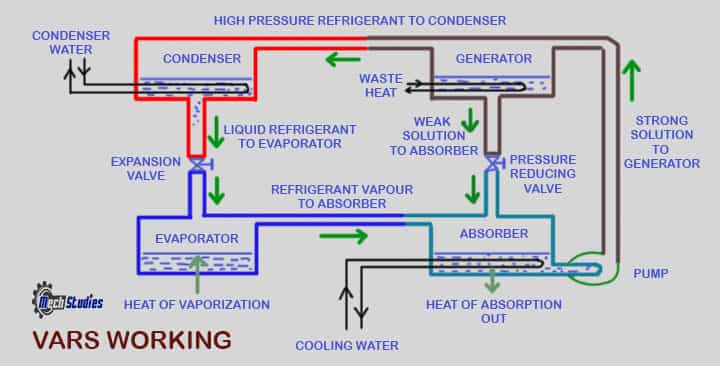
Let’s see the working principle,
Step:1 Refrigeration effect in evaporator
- The evaporator receives cold refrigerant from the expansion valve. The refrigerant in this case is liquid ammonia.
- Cold liquid ammonia will capture heat from the surrounding region of evaporator coils and perform a cooling or refrigeration effect.
- Once the heat is captured by liquid ammonia it gets converted to low-pressure vapor and leaves the evaporator.
Step:2 Absorption and Strong Solution
- After leaving the evaporator, the ammonia vapor enters the absorber.
- The absorber contains the weak solution of ammonia and water.
- When ammonia vapor is added to the weak solution, it becomes a strong solution.
- The water of a weak solution can absorb more ammonia at low temperatures.
- In contrast, at high temperatures, solute and solvent get separated.
- Absorber is cooled by cooling water circuit.
Step:3 Pumping Strong Solution to Generator
- From the absorber, the pump starts working to move a strong solution to the generator.
- Pump increases the pressure of the strong solution and circulate it to generator.
Step:4 Heat addition to generator
- Heat is provided to the generator from outside. This heat can be from electric or waste heat from the plant.
- The strong solution of ammonia and water capture heat and convert to vapor.
- The ammonia gets separated from the solution at high pressure and temperature.
- The ammonia left in the generator is in high pressure and high-temperature state.
Step:5 Heat removal at the condenser
- It reaches the condenser.
- Inside the condenser heat is removed from ammonia and it gets converted into liquid.
Step:6 Pressure drop through an expansion valve for Refrigerant
- After condenser, its pressure is still high so the pressure needs to be reduced. For this reason, liquid ammonia flows through the expansion valve.
- The expansion valve drops its pressure sharply.
- This causes ammonia to decrease its temperature and get chilled.
- This chilled ammonia finally enters the evaporator to cause cooling. This process is repeated continuously and refrigeration occurs in the evaporator every time.
Step:7 Pressure drop through a pressure reducing valve for Absorbent
- After leaving the ammnia from generator, the water quantity becomes more, that means that the solution again becomes weak.
- It required to transfer to the absorbent.
- But as the pressure is still high, we need to reduce the pressure as well and use one expansion valve.
- It helps to reduce the pressure and temperature as well.
Types of Vapor Absorption Refrigeration Cycles
The temperature of the heat source plays an important role in the vapor absorption refrigeration system. Once the heat is provided by the heat source, it can be used in one stage or in more than one. Based on this principle the single effect and double effect cycles are defined.
Single-Effect Cycle
In this cycle, the refrigerant and the absorbent are regenerated in a single step using a low-grade heat source (75° C to 150° C).
- If the temperature of the heat source is up to 105° C, heat is utilized in a single stage.
- The cycle at this stage is a single effect cycle.
- The Ammonia-water system is a practical example of a single-effect absorption cycle.
- In such a system, ammonia acts as a coolant, and water acts as an absorbent.
One generator is utilized to regenerate the refrigerant and absorbent. The size of the heat exchanger and generator is large having a high-volume flow.
Double-Effect Cycle
In this cycle, the refrigerant and the absorbent are regenerated in two steps using a medium-grade heat source (120° C to 185° C). We can use a double-effect cycle when the heat source temperature is greater than 105° C.
- This heat is utilized in two stages therefore, the cycle is called the double effect cycle.
- Vapors of refrigerants are generated in two stages; therefore, we need two heat exchangers.
- The steam produced in the first stage is used as the heat source for the second stage.
Two generators are utilized to regenerate the refrigerant and absorbent. One is the high-temperature generator (HTG) and another is the low-temperature generator (LTG). The size of the heat exchanger and generator is small as we split the generation process.
Advantages of Vapor Absorption Refrigeration Cycle
Following are the key advantages of the vapor absorption refrigeration cycle.
- This system has no moving parts, so it has less wear due to friction.
- Due to the absence of moving parts, it works quietly.
- A pump used in a vapor absorption cycle consumes less power than the compressor.
- It has low-cost maintenance due to the absence of moving parts.
- Corrosion problems are less.
- It can be used for high cooling loads (1000-ton capacity).
- The refrigerant used in the system does not emit any greenhouse gases.
- The performance of the system is not affected by load variations.
- It can be powered by various sources like steam, solar energy, exhaust from furnaces, etc.
Disadvantages of Vapor Absorption Refrigeration Cycle
- The vapor absorption system has the following disadvantages.
- It has low COP (Coefficient of Performance) values.
- The system is bulky and requires too large a space.
- The initial cost is high.
- Working pressure is low which affects COP.
- Proper setup for heat rejection is required as many components reject heat such as condenser, absorber, and analyser.
Applications of Vapor Absorption Refrigeration Cycle
- Vapor absorption refrigeration cycles have many uses. We need this system because the vapor compression system is costly and requires a high amount of power. It is best for areas where heat energy is available at a low price.
- This cycle is used in steam power plants. The waste heat from the powerplant can be utilized for refrigeration.
- It can be used for small-scale applications like home refrigerators and small capacity air conditions.
- On a large scale, the vapor absorption system provides cooling to large factories and commercial buildings.
- It can be used in areas where electricity is expensive and hard to obtain.
Performance of Vapor Absorption Refrigeration Cycle
A vapor absorption system is a heat-operated refrigerating machine. By applying heat, the refrigerant is separated from the strong solution in the generator.
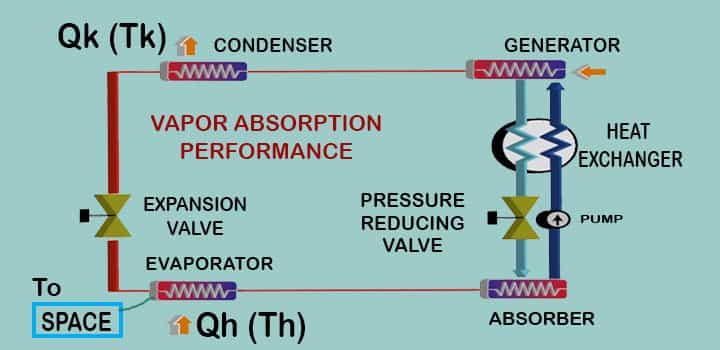
It is the combination of a heat engine and refrigerating machine.
- The COP (Coefficient of performance) depends on the temperatures of the system components such as heat source, condenser, absorber, and refrigeration space.
- The temperature of the hot source should be kept high, while the condenser and absorber should be operated at a low temperature.
Consider,
- Th = Temperature at which heat is supplied to the strong solution
- Tk = Temperature at which heat is rejected
- To = surrounding area temperature which needs to be refrigerated.
The maximum COP is given as;
- (C.O.P) max = (C.O.P) Carnot + η Carnot
- C.O.P = [(Th – Tk)/Th] x [(To – Tk)/To]
Desirable Properties of Refrigerant-Absorbent Combination
An ideal refrigerant-absorbent combination should have the following desirable properties.
- There should be a large difference in boiling points of refrigerant and absorbent.
- The refrigerant should have less affinity for the absorber at high temperature and high affinity for low temperature.
- The solution should have low viscosity to minimize pump work.
- Low specific heat and high chemical and thermal stability.
- The solution should have a low freezing point.
- All types of irreversible reactions like polymerization, decomposition, corrosion should be avoided.
Thermodynamic Requirements of Refrigerant-Absorbent Combination
To run the vapor absorption refrigeration cycle two thermodynamic requirements should be maintained, they are;
Solubility Requirement
The refrigerant used in the vapor absorption refrigeration cycle should have very high solubility in the absorbent material. To make a strong solution the refrigerant-absorbent pair should have more than Raoult’s law solubility.
Boiling Points Requirement
We need the only refrigerant to leave the generator and enter the condenser. Therefore, two substances should have a large difference in the boiling points (150 ° C to 200° C). This is needed so that at the generator temperature the absorbent exerts negligible vapor pressure. In the end, the absorbent-free refrigerant will leave the generator.
- The commonly used refrigerant-absorbent pairs are ammonia-water and lithium bromide-water.
- The ammonia-water system has good solubility but the difference in boiling points is 138° C.
- It means the vapor leaving the generator will contain some amount of water.
Conclusion
This is the complete discussion about the vapor absorption cycle. Understanding this cycle is not any task. Therefore, an effort is made to cover each section properly and make it easily understandable. If you have any queries regarding any part of this topic, put your questions in the comments section. We will answer you soon. Thanks for reaching up to this point.
